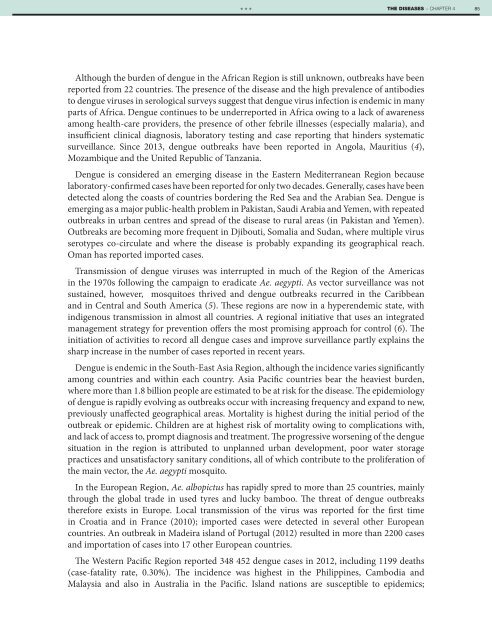1A9bnbK
1A9bnbK
1A9bnbK
Create successful ePaper yourself
Turn your PDF publications into a flip-book with our unique Google optimized e-Paper software.
***<br />
THE DISEASES − CHAPTER 4<br />
85<br />
Although the burden of dengue in the African Region is still unknown, outbreaks have been<br />
reported from 22 countries. The presence of the disease and the high prevalence of antibodies<br />
to dengue viruses in serological surveys suggest that dengue virus infection is endemic in many<br />
parts of Africa. Dengue continues to be underreported in Africa owing to a lack of awareness<br />
among health-care providers, the presence of other febrile illnesses (especially malaria), and<br />
insufficient clinical diagnosis, laboratory testing and case reporting that hinders systematic<br />
surveillance. Since 2013, dengue outbreaks have been reported in Angola, Mauritius (4),<br />
Mozambique and the United Republic of Tanzania.<br />
Dengue is considered an emerging disease in the Eastern Mediterranean Region because<br />
laboratory-confirmed cases have been reported for only two decades. Generally, cases have been<br />
detected along the coasts of countries bordering the Red Sea and the Arabian Sea. Dengue is<br />
emerging as a major public-health problem in Pakistan, Saudi Arabia and Yemen, with repeated<br />
outbreaks in urban centres and spread of the disease to rural areas (in Pakistan and Yemen).<br />
Outbreaks are becoming more frequent in Djibouti, Somalia and Sudan, where multiple virus<br />
serotypes co-circulate and where the disease is probably expanding its geographical reach.<br />
Oman has reported imported cases.<br />
Transmission of dengue viruses was interrupted in much of the Region of the Americas<br />
in the 1970s following the campaign to eradicate Ae. aegypti. As vector surveillance was not<br />
sustained, however, mosquitoes thrived and dengue outbreaks recurred in the Caribbean<br />
and in Central and South America (5). These regions are now in a hyperendemic state, with<br />
indigenous transmission in almost all countries. A regional initiative that uses an integrated<br />
management strategy for prevention offers the most promising approach for control (6). The<br />
initiation of activities to record all dengue cases and improve surveillance partly explains the<br />
sharp increase in the number of cases reported in recent years.<br />
Dengue is endemic in the South-East Asia Region, although the incidence varies significantly<br />
among countries and within each country. Asia Pacific countries bear the heaviest burden,<br />
where more than 1.8 billion people are estimated to be at risk for the disease. The epidemiology<br />
of dengue is rapidly evolving as outbreaks occur with increasing frequency and expand to new,<br />
previously unaffected geographical areas. Mortality is highest during the initial period of the<br />
outbreak or epidemic. Children are at highest risk of mortality owing to complications with,<br />
and lack of access to, prompt diagnosis and treatment. The progressive worsening of the dengue<br />
situation in the region is attributed to unplanned urban development, poor water storage<br />
practices and unsatisfactory sanitary conditions, all of which contribute to the proliferation of<br />
the main vector, the Ae. aegypti mosquito.<br />
In the European Region, Ae. albopictus has rapidly spred to more than 25 countries, mainly<br />
through the global trade in used tyres and lucky bamboo. The threat of dengue outbreaks<br />
therefore exists in Europe. Local transmission of the virus was reported for the first time<br />
in Croatia and in France (2010); imported cases were detected in several other European<br />
countries. An outbreak in Madeira island of Portugal (2012) resulted in more than 2200 cases<br />
and importation of cases into 17 other European countries.<br />
The Western Pacific Region reported 348 452 dengue cases in 2012, including 1199 deaths<br />
(case-fatality rate, 0.30%). The incidence was highest in the Philippines, Cambodia and<br />
Malaysia and also in Australia in the Pacific. Island nations are susceptible to epidemics;


